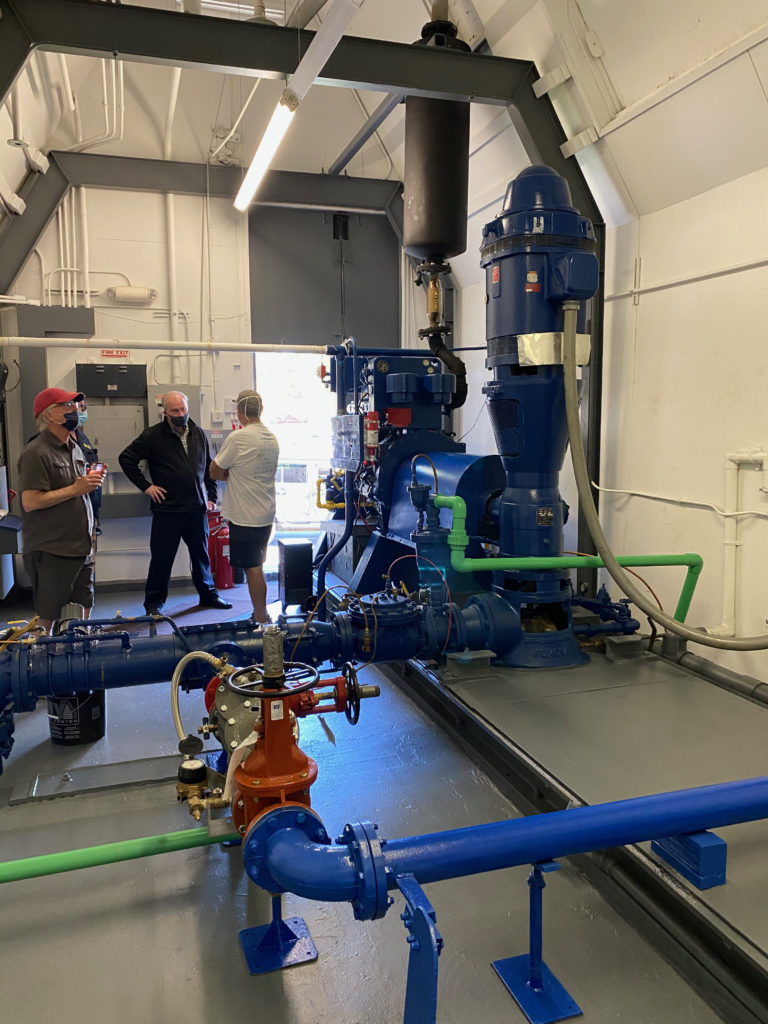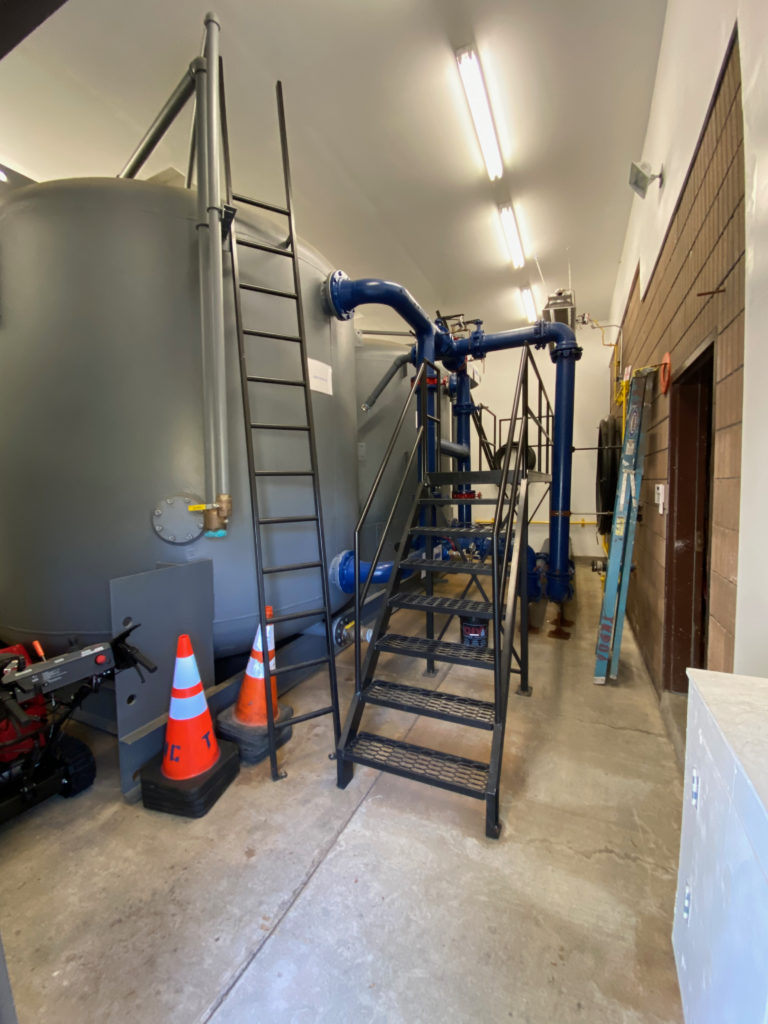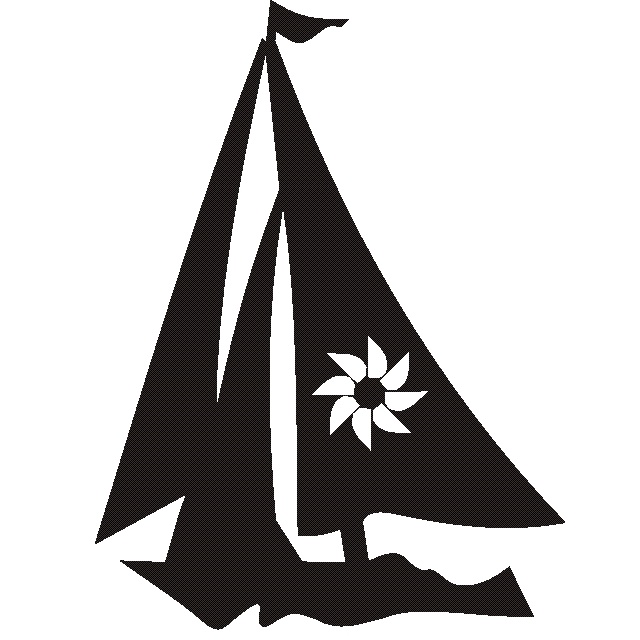Water Shortage
Starting July 26th non-turf irrigation will no longer be prohibited for all water serviced properties and commercial customers of the Tahoe Keys Water Company (turf irrigation is still prohibited).

Prohibition of Landscape Irrigation
Starting July 26th non-turf irrigation will no longer be prohibited for all water serviced properties and commercial customers of the Tahoe Keys Water Company (turf irrigation is still prohibited).
Why?
This situation is quite unprecedented in the Keys’ fifty-plus-year history.
Backstory:
- Our Water Company has three wells that provide the water for the Tahoe Keys.
- One of our wells has been shut down due to elevated levels of naturally occurring uranium.
- A second well is at the maximum contaminate level (MCL) for uranium and is set to as a standby only.
- Our remaining well cannot meet the peak demands through the summer caused by landscape irrigation.
So, like much of California this year, we face a ban on irrigation and the prospect of brown lawns and possible damage to our landscaping, both personal and common.
This is not a pleasant prospect for any of us, but we cannot overstate the seriousness of the problem we face; brown lawns and landscaping are the least of our concerns should we be unable to provide safe drinking water.
Resumption of Non-Turf Irrigation Starting July 26th
The Board of Directors has approved the resumption of non-turf irrigation starting on Monday, July 26th based on revised irrigation rules and schedule.
Read the latest news.
Stay up to date on what’s happening regarding the water shortage.
The Future of Tahoe Keys Water Company
During July’s Board Meeting Farr West presented the results of their analysis of the long-term operations and maintenance options for our Water Company. As I’m sure you recall, we faced a crisis last year when one of our three wells was taken offline due to excessive levels of uranium. It was feared a second well…
Tahoe Keys Water Company (TKWC) Long Term Facilities Plan Presentation 10-28-2021 Town Hall Forum
LRFP-Presentation-without-photos-102821Download
Tips for Lawn Recovery
ASSESS THE DAMAGE. Grass species can withstand three to four weeks of dormancy andstill survive. Inspect closely. Look at your grass at the crown — that is the base of the plant,just above the roots, where the individual blades emerge. If the crown is whitish and the newblades are green, the plant is still living.…
How did we get here?
While our wells have been under threat by the PCE contamination that has been slowly spreading towards the Tahoe Keys, this current crisis has been caused by unexpected levels of naturally occurring uranium that have impacted two of our wells.
2017: Our first indication of a problem.
Back in 2017 State-mandated tests for Well #3 showed elevated levels of uranium, but well below EPA levels for safe drinking water. These levels required TKWC to increase the frequency of tests to every three years.
July 2020: Routine testing three years later.
In July 2020, it was time to retest Well #3 for uranium. Unfortunately, the results showed levels of uranium slightly above the EPA-mandated maximum level (31 ppb versus the maximum level of 30 ppb).
Based on these elevated levels, we now had to test quarterly, for the next four quarters. Should the average level of uranium over these four quarters be above the mandated level, the well would be shut down. Leaving us only two wells.
November 12th, 2020: A second black mark.
The second quarter test results for Well #3 came back with similarly elevated levels of uranium (32 ppb).
At a special joint meeting of the Board of Directors and Water Quality Committee on November 16th, the board directed staff to initiate discussions with STPUD given the mounting issues faced by our wells and to begin drafting an RFP for a long-term facilities plan to address the multiple contaminates now threatening all three wells.
November 17th, 2020: A double-whammy.
Unexpectedly, the routine test results for Well #2 came back showing high levels of uranium (48 ppb). Well #2 was already offline for the season to reduce the use of filters that had to be installed back in 2010 due to elevated levels of PCE.
A test sample taken after the filtration system indicated levels of uranium over 150 ppb, indicating a high concentration of uranium in the filter medium and effectively shutting down this well.
December 16th, 2020: Long-term facilities plan.
Our Staff and Water Quality Committee turned around a request for proposal (RFP) in record time to solicit engineering firms to help us develop a long-term facilities plan to address the issues faced by our Water Company. The Board approved the RFP during the December 16th Board Meeting.
December 22nd, 2020: State-mandated homeowner notification.
After discussion with State Agencies, TKWC notified homeowners of the elevated levels of uranium at Well #2, informing them this well was no longer online.
January 2021: Advisory Committee established.
At the January 20th Board Meeting, the Board established an Advisory Committee of homeowners and outside experts to review the proposals submitted in response to our RFP.
February 2021: Selection of engineering firm.
During the February 17th Board Meeting, the Advisory Committee provided their recommendations and MC Engineering was awarded the contract to develop a long-term facilities plan for our Water Company.
However, as per the RFP, the first job was to rapidly develop short-term recommendations to address the possibility that if Well #3 tested above the mandated levels of uranium in April that the Water Company would be down to only one well.
March 2021: Emergency actions.
On March 11th, 2021, the Board of Directors held an Emergency Board Meeting to review and discuss the short-term recommendations from our advisory Committee and MC Engineering.
Due to the unprecedented severity of the water shortage and the need to ensure our Water Company would be able to provide safe drinking water, the Board put into effect a landscape irrigation ban as of April 1st, 2021 through November 1st, 2021.

What are we doing about it?
Health and safety is job number one. With two of our wells shut down (due to elevated uranium levels), the Board’s immediate concern was to ensure our Water Company could continue to provide safe drinking water.
At the March 11th Board Meeting, the Board approved $600,000 of emergency reserve expenditure to purchase six temporary uranium treatment units to be installed at our shut down well and our well that is at the maximum allowed level. These units will allow us to pump a limited capacity of safe drinking from each well to supplement our remaining unaffected well (and ensure that we don’t have a single point of failure in our water system).
With this in place, the Board, our Staff, and Advisory Committee continue to investigate additional measures that we may be able to undertake to ease the irrigation ban at some point through the summer. During the April 19th Special Board Meeting, the Board approved an additional $800,000 in emergency reserve expenditure to potentially mitigate the irrigation ban to some degree and provide additional redundancy and resiliency for our Water Company operations:
- Inter-tie with Lukins Brothers Water Company (LBWC)
The Board approved establishing an inter-tie with LBWC along 15th Street. LBWC is able to provide an additional 500 gallons of water per minute (gpm) should we need it. This inter-tie will also give us a level of redundancy should installing the treatment units at our two wells run into issues, or we face additional issues with one of our wells at some point. It also provides capacity that might allow us to ease up on the irrigation ban. - Supervisory Control and Data Acquisition (SCADA)
The Board approved the installation of a monitoring and automated control system at our wells. Unfortunately, we have historically underfunded our Water Company infrastructure. We currently have no minute-by-minute monitoring and control of our wells. Everything is manually operated. This has been a significant issue as we face this crisis because we really have no idea what our peak water demands are hour-by-hour; we have had to make some gross assumptions and best estimates when determining our water needs. Also, installing temporary treatment at two of our wells will significantly increase the complexity of operation for our Water Company staff. With this system in place, we will monitor our water demands minute-by-minute and gauge whether we have sufficient supply to allow some level of irrigation. - Water Meters
The Board approved the installation of water meters across our common areas. Our best estimate is that our common areas account for thirty percent of our irrigation use. But, unfortunately, without any meters, we are somewhat guessing. These meters will allow us to see how much water we are using and, more importantly, how effective we can be at reducing usage.
Our hope is that with these three things in place, our Water Company will be able to better model our water demands through the day. If so, then possibly we’ll be able to allow a reduced amount of landscape irrigation for everyone. But we cannot emphasize enough, this is just a hope; there are no guarantees until we get everything in place and we’re able to experiment bit-by-bit.
The best-case scenario is that sometime around mid-July, the Board may be able to lift the irrigation prohibition and institute a schedule of limited irrigation through the rest of the summer. Until then, I’m afraid the irrigation ban stands.
Frequently asked questions.
We’re sure you have many questions regarding this water shortage and the measures being taken to ensure our Water Company is able to supply safe drinking water. We have tried to answer some of the common ones here.
While we do not have all the answers at this time, if you have any concerns or questions, do not hesitate to reach out to our General Manager, Kirk Wooldridge (kwooldridge@tahoekeyspoa.org).
What is the long-term strategy?
Any long-term strategy could take us two or more years to put in place. The Board has authorized $1.4MM in unplanned reserve expenditure to see us through until then. These funds will have to be replenished as part of the overall funding for the long-term solution (we are borrowing from our Common Reserve for the time being).
The long-term solution could total $5MM to $10MM. We don’t share this to scare you, but to be fully transparent about what we face. Our engineering firm is evaluating all the options open to us. Hopefully, by mid this year, the Board will be able to determine the best way forward. We’ll certainly look at different ways to fund the needed investments and endeavor to keep everyone informed over the coming months.
Where can I find the current irrigation rules and schedule?
Starting on July 26th homeowners will be allowed to resume non-turf landscape irrigation based on revised irrigation rules and an updated irrigation schedule.
Can I use alternate water sources to irrigate my landscape?
At the May 19th Board Meeting the Board approved an interim irrigation program to allow homeowners to use alternate sources of water for their landscape irrigation.
It requires that homeowners submit an application to the ACC and all installations will need to be inspected by our Water Company to ensure there are no cross-connections to our water system.
It is likely this program will be rescinded once full landscape irrigation has been restored.
Can I use water from the lagoons to water my landscape?
To the best of our knowledge, unfortunately not. Water rights is a complex issue and after checking with the Federal Water Master’s office in Reno, it appears that TKPOA and homeowners do not have rights to draw water from the lake under the Truckee River Operating Agreement (TROA). You can read more about our research on this subject by clicking below.
Where can I learn more about the long-term facilities plan?
The Projects subfolder of the Water Company folder under the Documents section of this website contains all the documents related to the long-term facilities plan.
Tips to save a drought-stricken lawn
Here’s a helpful article that outlines some steps on how to weather a drought. The only caveat is that we can, of course, not use phosphorus-based fertilizers, as it recommends.
Meet our incredible Oversight Committee.
The Board created the TKWC Long Term Facilities Plan Oversight Board Subcommittee to help Staff and our engineering firm identify short, intermediate and long-term plans to address our water shortage.

John Larson
Committee Chair

Rick Lind
Committee Member

Jeff Flairty
Committee Member

Keiron McCammon
Committee Member
I’ve owned in the Keys since 2008 and currently live here full-time as of 2020. I joined the Board last year.
Emergency notices, policies, fees and projects.
You can find documents related to the Water Company in the documents section of the website. This includes emergency notices, guidelines, policies, and fees as well as project information.

